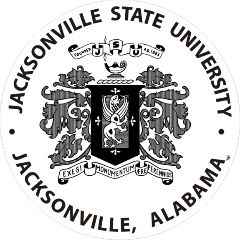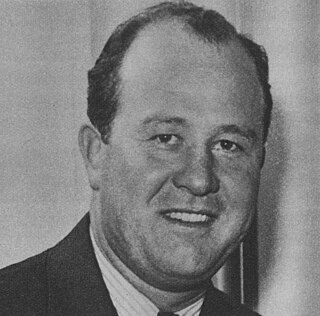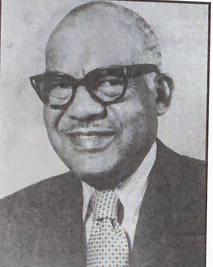
Jacksonville State University is a public university in Jacksonville, Alabama. Founded in 1883, Jacksonville State offers programs of study in six academic schools leading to bachelor's, master's, education specialist, and doctorate degrees in addition to certificate programs and continuing education opportunities.

William Wallace Wade was an American football player and coach of football, basketball, and baseball, and college athletics administrator. He served as the head football coach at the University of Alabama from 1923 to 1930 and at Duke University from 1931 to 1941 and again from 1946 to 1950, compiling a career college football record of 171–49–10. His tenure at Duke was interrupted by military service during World War II. Wade's Alabama Crimson Tide football teams of 1925, 1926, and 1930 have been recognized as national champions, while his 1938 Duke team had an unscored upon regular season, giving up its only points in the final minute of the 1939 Rose Bowl. Wade won a total of ten Southern Conference football titles, four with Alabama and six with the Duke Blue Devils. He coached in five Rose Bowls including the 1942 game, which was relocated from Pasadena, California to Durham, North Carolina after the attack on Pearl Harbor.

Bernard W. Bierman was an American college football coach best known for his years as head coach of the Minnesota Golden Gophers football program. Between 1934 and 1941, his Minnesota teams won five national championships and seven Big Ten championships and had four perfect seasons. Bierman's five national championships rank him among the greatest college football coaches of all time, as only 2 coaches have won more.
The 1927 Georgia Bulldogs football team represented the University of Georgia in the sport of American football during the 1927 Southern Conference football season. This was the last season George Cecil Woodruff served as the head coach of the football team and the team's 34th season of college football. The Bulldogs posted a 9–1 record, and were retroactively selected as the 1927 national champion under the Berryman QPRS, Boand, and Poling systems. The team was ranked No. 8 in the nation in the Dickinson System ratings released in December 1927.
Jon Thomas Hand is an American former professional football player who was a defensive end for the Indianapolis Colts of the National Football League (NFL) for nine seasons. Hand was selected by the Colts with the fourth overall pick in the 1986 NFL draft. He played college football at Alabama.

Robert Barton "Bullet Bob" Westfall was an American football fullback who played for the University of Michigan (1939–1941) and the Detroit Lions (1944–1947). He was a consensus first-team All-American in 1941 and a first-team All-Pro player in 1945. In 1987, Westfall was enshrined in the College Football Hall of Fame.

William Miller Edwards was an American football player and coach. He served as the head football coach at Western Reserve University, Vanderbilt University and Wittenberg University in a career lasting more than 30 years, compiling a win-loss-tie record of 168–45–8. Edwards also coached the Detroit Lions of the National Football League (NFL) from 1941 to 1942, tallying a 4–9–1 record, and served as an assistant coach for the NFL's Cleveland Browns in the late 1940s.

William James Nicks was an American college football player and coach. He coached at historically black colleges in the Southern United States from 1930 to 1965. Nicks served as the head football coach at Morris Brown College in Georgia and at Prairie View A&M University in Texas. He was the NAIA Football Coach of the Year in 1963 and his teams were declared the black college football national champions six times. Nicks was inducted into the College Football Hall of Fame as a coach in 1999.
Joseph John Domnanovich was an American professional football player who was a center for six seasons in the National Football League (NFL) for the Boston Yanks (1946–1948) and the New York Bulldogs/Yanks (1949–1951). Prior to his professional career Domanovich played college football for the Alabama Crimson Tide under Coach Frank Thomas from 1938 to 1942.

George Washington Carver High School is a public high school in Montgomery, Alabama. It is a part of the Montgomery Public Schools system. The groundbreaking for a new Carver High School was held April 2, 2008, at the construction site just off Oak Street across from the existing school. Its design utilizes modern advances in architecture, construction and technology. The $36 million school is the first of six new schools scheduled in the first phase of the MPS building program. The Carver High School ribbon cutting ceremony was held in August 2010 with the school serving approximately 1,200 students.

The 1925 Alabama Crimson Tide football team represented the University of Alabama in the 1925 Southern Conference football season. It was the Crimson Tide's 32nd overall and 4th season as a member of the Southern Conference (SoCon). The team was led by head coach Wallace Wade, in his third year, and played their home games at Denny Field in Tuscaloosa, at Rickwood Field in Birmingham and at the Cramton Bowl in Montgomery, Alabama. They finished the season with their first ever perfect record, as Southern Conference champions, defeated Washington in the Rose Bowl, and were retroactively named as national champion for 1925 by several major selectors.
The Anniston Moulders were a minor league baseball team based in Anniston, Alabama. From 1913 to 1917, the "Moulders" played as members of the Class D level Georgia–Alabama League. The team was immediately preceded by the 1911 and 1912 Anniston "Models," who played as members of the Class D level Southeastern League and the 1904 Anniston team of the independent Tennessee–Alabama League. Anniston won league championships in 1911 and 1917.
Albert Hobson "Silent Al" Clemens was an American football, basketball, and baseball player and coach and college athletics administrator.

Chester C. Dillon was an American football player, coach of football, basketball, and baseball, college athletics administrator, and educator. He was the head football coach at Dakota Wesleyan University (1915), Simpson College in Indianola, Iowa (1916–1917), Howard College in Birmingham, Alabama—now known as Samford University, Oshkosh State Normal School—now known as the University of Wisconsin–Oshkosh (1920), Georgetown College in Georgetown, Kentucky (1929–1930), and Jacksonville State Teachers College—now known as Jacksonville State University. Dillon also served as the athletic director at each of those schools.
The 1921 Talladega football team was an American football team that represented the Talladega College during the 1921 college football season. In its second season under head coach Jubie Bragg, the team compiled a – record. Talladega was recognized as the 1921 black college national co-champion.
The 1942 Delaware State Hornets football team represented the State College for Colored Students—now known as Delaware State University—in the 1942 college football season as an independent. Led by first-year head coach Dyke Smith, the Hornets compiled a 3–1–1 record.
The 1992 Jacksonville State Gamecocks football team was an American football team that represented Jacksonville State University as a member of the Gulf South Conference (GSC) during the 1992 NCAA Division II football season. In their eighth year under head coach Bill Burgess, the team compiled an overall record of 12–1–1 with mark of 5–0–1 against conference opponents, winning the GSC title. For the fifth consecutive season, Jacksonville State advanced to the NCAA Division II Football Championship playoffs, beating Savannah State in the first round, North Alabama in the quarterfinals, New Haven in the semifinals, and Pittsburg State, 17–13, in the championship game.

Felmon Devoner Motley was an American football player and civil rights advocate. He played fullback and lineman for the Alabama A&M Bulldogs and the Delaware State Hornets. He was inducted into the Delaware Sports Museum and Hall of Fame in 1998.

George H. "Hoss" Hobson was an American athlete and sports coach. After playing college football for Alabama State, Hobson began a coaching career at several high schools, leading his teams to four state championships. In c. 1941, he began his tenure at Alabama A&M University, for which he was best known. He served as head football coach from 1942 to 1959, and was also the athletic director for many years. In the latter position, he revived the school's baseball team and added the sports of basketball, tennis, and golf, serving as the head coach of each for a time. Hobson later served as commissioner of the SIAC and was inducted into both the NACDA and Alabama A&M Halls of Fame.











